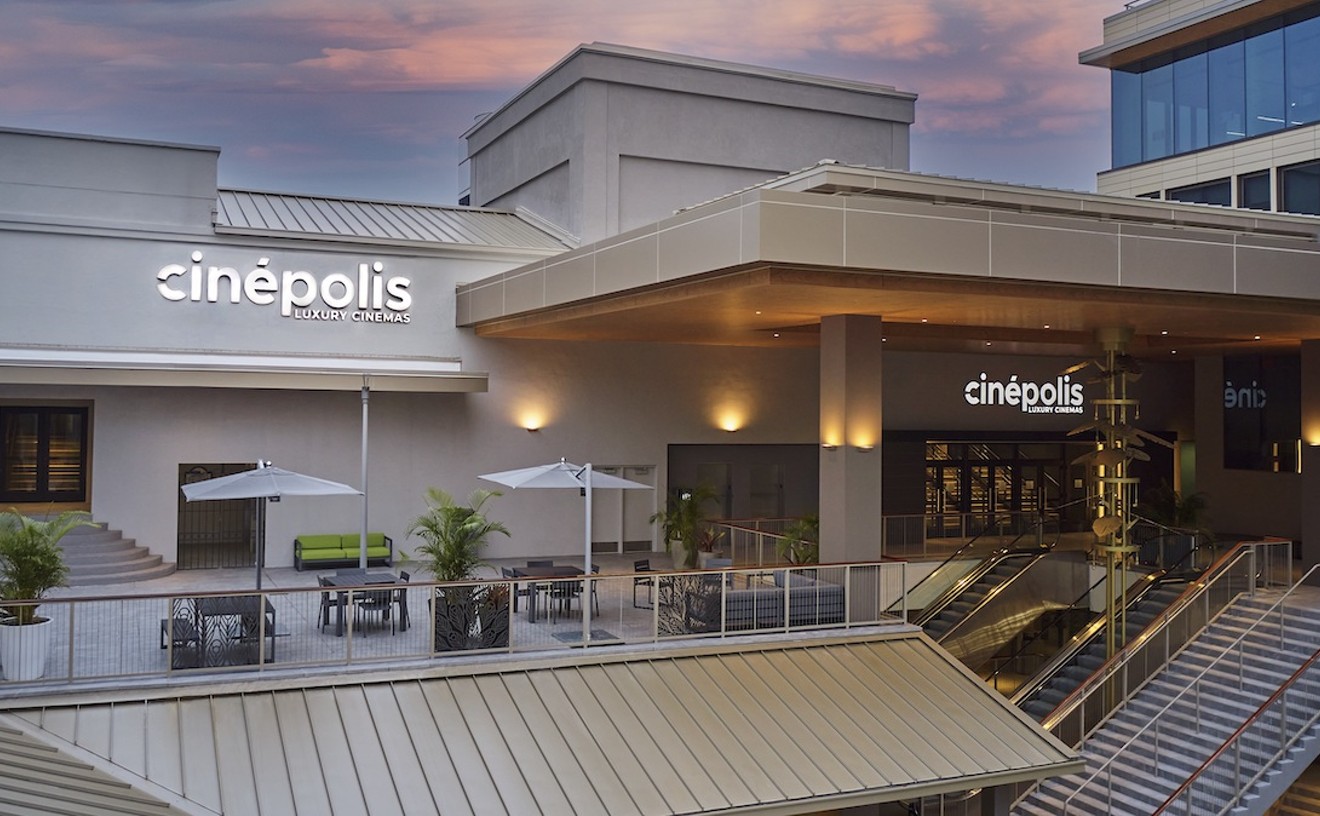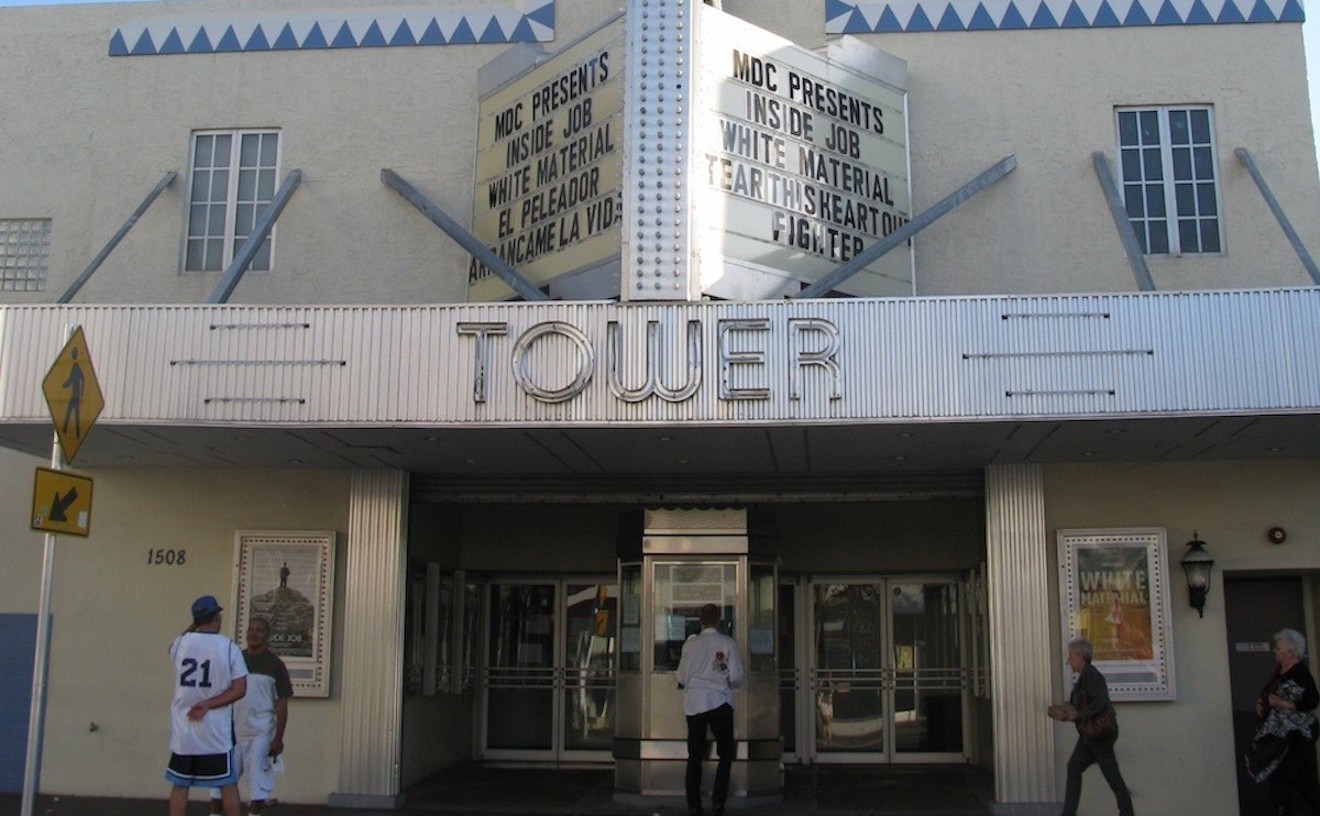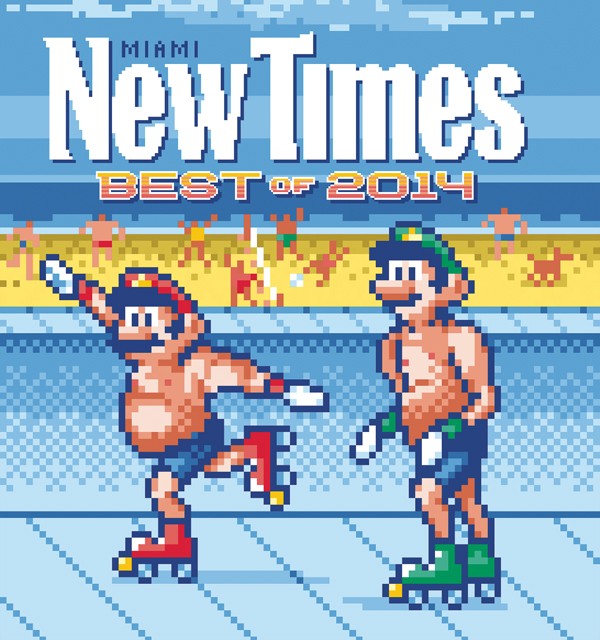For film worshippers, movie theaters are the temple where an escape to a higher plane begins. Usually, it's the cinema that transports viewers to endless faraway realms, but what if the theater itself also did some of the heavy lifting? Thanks to one Austin, Texas man determined to revive a forgotten art in Miami, that's exactly what a new mini drive-in theater does. The Blue Starlite Mini Urban Drive-In, which opened in summer 2013, became a darling of the Wynwood neighborhood. Don't expect to drive up and see the latest blockbuster, though, because the Blue Starlite plays only movies of yesteryear — "indie films, art house, cult, Gen X/Y, childhood favorites, and drive-in classics," to be exact. Expect to see classic films such as Casablanca, The Blob, The Princess Bride, The Rocky Horror Picture Show, and perhaps the occasional movie released in the past decade. After only a few short months, the theater expanded to Virginia Key Beach, where moviegoers can enjoy classic flicks under the twinkling stars while cuddled up with their honeys on a sandy beach during fall and spring. And now the Blue Starlite has moved from Wynwood to a new location behind the Coconut Grove Playhouse, which is slated to open this July. The drive-in charges per car and per person in each car, but oftentimes you can get a deal for $30 that includes entry for one car slot, two people, and popcorn. Whether you go for the classic films or the outdoor ambiance, a trip to the drive-in is always a perfect way to spend a few hours away from the real world.
Best Movie Theater
Blue Starlite Mini Urban Drive-In

- 3015 Grand Ave., Miami, 33133 Map
- 305-446-6843
- cinepolisusa.com/our-locations/x0il8-cinepolis-coconut-grove
Best Art-House Cinema
Tower Theater

In August 2013, Calle Ocho's landmark movie theater closed for renovation. It finally reopened this past March, illuminating the neighborhood with its iconic marquee once again. Thank the cinematic gods! Because before the current art-house cinema craze, Tower was one of the first to bring foreign and independent cinema to the Magic City. It originally opened in 1926 as a state-of-the-art theater. In the '60s, it helped newly arrived Cuban refugees acclimate to American culture by screening English-language films with Spanish subtitles. Now, under the auspices of Miami Dade College, it continues to educate the public through a cultural exchange of thought and creativity on celluloid. You won't find any blockbusters here, but you have plenty of other options. Instead, for a $10 ticket you can watch some of the most underrated, obscure, and, yes, occasionally infuriatingly slow-paced works from across the globe. Unlike most of our local art-house theaters, Tower features two viewing rooms, for twice the cinematic fun. And along with Miami's other art-house film havens, it's proving that films can still entertain and move audiences without the help of IMAX screens and 3-D technology.
- 1508 SW Eighth St., Miami, 33135 Map
- 305-237-2463
- www.towertheatermiami.com
Best Movie Shot in Miami
Iron Man 3
Tony Stark had been rattled to his core. The brilliant inventor, playboy, and superhero was already suffering a righteous PTSD meltdown from the carnage that invading aliens had wrought on New York City, when a mysterious figure called the Mandarin began blowing up buildings left and right. So Stark — never lacking confidence — took to television to call out the mysterious figure, promise revenge, and even offer his home address. He didn't expect what came next: a full-out assault by armored helicopters that sent his high-tech home plunging into the ocean and nearly killed the guy everyone knows best as Iron Man. But Stark survived, and by following a series of clues, he pieced together the Mandarin's true identity and traced him to his secret lair. As Stark jetted across the water and swooped in for a final showdown, the camera zoomed in on the palatial retreat, and... wait a second. Is that Vizcaya? Yes, indeed. Miami residents could have saved the star of Iron Man 3, played by Robert Downey Jr., weeks of agony and billions in expense by pointing him toward the Mandarin's hideout, which — at least on film — is among the Magic City's most famed locales. But damned if it didn't make a great backdrop for a knockdown brawl between Stark and his nemesis, played by the legendary Ben Kingsley. Beyond all the onscreen glory, the blockbuster reportedly pumped $15 million in revenue into Miami's film industry during filming, with Vizcaya nabbing $100,000 in revenue and location fees. Any other cyborg heroes and villains want to come blow up the Magic City?
Best TV Show Shot in Miami
Burn Notice
There are so many ways to get burned in Miami: by the sun, tacky tourist shops, sketchy drug deals. But what if you're a spy? Just ask Michael Westen. He was one of the best in the business before a mysterious enemy had him burned. In spy terminology, that means he became untouchable — as Westen himself put it at the beginning of every episode of his hit show Burn Notice: "When you're burned, you've got nothing: no cash, no credit, no job history. You're stuck in whatever city they decide to dump you in." Luckily for Westen — and Miamians — he is shunned in the sunniest place imaginable: South Beach. For six years and seven seasons, Burn Notice's star character, played by Jeffrey Donovan, fought to regain his lost life while helping regular Miami joes with their own high-octane problems. It was a playful, action-packed show, sometimes silly but always entertaining. Between Westen's party-life best friend, played by Bruce Campbell, and all the beautiful beach babes, there was something for everyone: romance, action, comedy, heart-warming family moments. And best of all, unlike so many other SoBe imitators, from CSI: Miami to Dexter, the entire series was actually filmed right here in South Florida, based out of the old convention center space near Dinner Key. The hit show, which aired in more than 60 countries, wrapped for good last September. Did Westen ever get his revenge or his life back? You'll just have to tune in to reruns find out.
Best TV News Anchor
Trina Robinson
Perhaps you woke up every morning this winter and glanced out the window at the robin's-egg-blue skies, relished the mid-60s temperatures, and profusely thanked your preferred deity that you found a way to call South Florida home. But in case your personal comfort and sanity weren't reason enough to thank the Miami weather gods, they've given residents another invaluable gift: NBC 6 news anchor Trina Robinson. Robinson is as talented as they come, with a background in investigative reporting, anchoring, and meteorology; a pitch-perfect deep voice; and a charismatic on-air presence. But if it weren't for those sunny winter mornings, she'd probably be plying her trade up North somewhere. "Mostly the weather" keeps her in town, Robinson told New Times last year. "You can be outside every day; you don't have to worry about snow — I have a total aversion to snow." Robinson's reporting has garnered multiple Emmys, and she's been in front of several big news stories in recent years, including breaking pieces about a ring illegally injecting deadly silicone mixtures into transgender women. Crack open your windows, catch that sea breeze, and tune in to NBC 6. We're a lucky town.
Best Spanish-Language TV Personality
Guillermo Benites
If Ron Burgundy had an Argentine uncle, his name would be Guillermo Benites. For more than 34 years, the Buenos Aires native has anchored the 6 p.m. news for Univision's flagship Miami station. With his deadpan baritone and stoic demeanor, Benites has held the attention of Miami's Spanish-speaking viewers through some of the city's most historic moments — from Pope John Paul II's ride in 1987 to the Elián González saga in 2000 to the recent acquittal of former Hialeah mayor Julio Robaina and his wife on tax evasion charges. Benites moved to Miami in 1968 and began an illustrious radio career that lasted into the early 1980s before he left the airwaves to help launch Univision, where he has worked as a meteorologist and senior news anchor. Benites has been recognized with a lifetime achievement award by the Suncoast Chapter of the National Academy of Television Arts & Sciences and has nabbed awards from dozens of cities and counties in South Florida for his long journalism career. Stay classy, Guillermo!
Best TV News Reporter
Michele Gillen
No one goes willingly to the ninth floor of the Miami-Dade jail. In a decaying, overheated building full of criminals of every stripe passing the hours until their day in court, the ninth floor is different. That's where the mentally ill, the disturbed, and the destitute who desperately need psychiatric attention (which they'll probably never get) are sent to suffer away from the public eye. They're put there so residents can ignore them. That's why it's called "the forgotten floor," a place most Miamians would be happy to pretend doesn't exist. Not Michele Gillen. Last summer, she spent days on the ninth floor hearing firsthand the stories of the men and women trapped in Miami-Dade County's labyrinthine mental health limbo. Her investigative piece, aptly titled "The Forgotten Floor," is exactly the kind of boundary-pushing broadcast journalism that has made Gillen among the most decorated reporters in Miami history. Gillen first made her mark on the national stage while reporting for Dateline, Exposé, and NBC Nightly News — where one in-depth piece sparked new federal legislation on mammography equipment — before moving on to local work in Los Angeles and finally Miami's CBS 4. Gillen has earned a closetful of prizes, including Emmys, Green Eyeshades, and an Edward R. Murrow Award for investigative reporting. Today, she's still at the frontline of Miami's investigative corps, using her cameras to shine a light on the darkest places in Dade County.
Best Meteorologist
John Morales
What do Hurricanes Andrew, Irene, and Wilma have in common? Other than the billions of dollars in property damage, the terrifying hours of pelting wind and rain, and the weeks of misery for millions of South Floridians, there's one other thread linking the meteorological monstrosities: John Morales. In a transitional city where the constants are few, Morales is a rare bedrock in the media landscape, a topnotch, cool-as-cucumber presence at the weather desk. And he's hardly resting on his forecasting laurels — Morales is one of the most decorated weathermen in the nation. Raised in Puerto Rico and educated at Cornell, Morales joined Univision and its local affiliate, WLTV, in 1991, moved to Telemundo in 2003, and joined NBC 6 in 2009. In between, he's found time to author or co-author two books, advise Al Gore on global warming trends, and become the first Hispanic to appear as the Today Show's meteorologist. He has also won three Emmys, and in his free time he teaches at St. Thomas University and pilots airplanes. In other words, he's exactly the guy you want in your neck of the woods, glued to a weather computer when the next tropical wave whips off the coast of Africa and churns toward hurricane strength in the Caribbean.
Best Sportscaster
Eric Reid
It doesn't matter how many points LeBron, D-Wade, and Chris Bosh score. For true Heat fans, the game-time action doesn't feel real without a blow-by-blow description from Eric Reid. Going on his 26th season with the Heat, the sportscaster has been with the NBA champs so long he was once calling out Rony Seikaly dunks. In all, he's covered 1,865 regular-season games. Reid — who earned his chops at Ithaca College while working as an analyst and play-by-play announcer for Cornell University's basketball team — started as the Heat's color analyst in 1988 and, after three seasons, took on the role of play-by-play for radio and television. After he was bumped up as Miami's play-by-play guy in 1991, he became puro Heat. Today, Reid is synonymous with the team — he's one of eight original Miami Heat employees still cashing Mickey Arison checks every month. Known for his enthusiastic interjections of "kaboom," spontaneous plays on names — such as "Udonis, you did it" and "Chris Ka-Bosh" — and appearances as host on Inside the Heat, he won a 2013 Emmy for best play-by-play announcer. Though LeBron has racked up a slew of MVP awards, for many citizens of the Heat Nation, Reid is the heart and soul of this franchise. No matter how many trophies Miami brings to the AAA, the Heat wouldn't be the Heat without Reid calling the action.
Best Radio Show
The Warp Zone With Jackson Alexander Parodi
Ever get a bad case of radio déjà vu? In Miami, it's an all-too-common condition, brought on by suffering through the same three songs ad nauseam until they are replaced by a different rotation of similar-sounding pop tracks until you feel like you've fallen down a Lady Gaga spiral of insanity. Do not panic. Science has a cure, and it's found on the University of Miami's college radio station, WVUM. The Warp Zone With Jackson Alexander Parodi plays only videogame music, and though that might sound like a premise with a serious and insurmountable limitation, it's really a gateway to a completely different — and often downright amazing — realm of music. The show is a sweet mix of nostalgia, orchestral jams, and intelligent dance music, and even though The Warp Zone doesn't play proper rock, it presents many opportunities to rock out in your car. When your trip's soundtrack comes from Zelda's Hyrule Kingdom, it's easy to forget you're traveling in the mundane real world. Ever speed down the Palmetto while listening to music from Mario Kart? You won't have a care in the world. (But maybe watch out for banana peels.)





